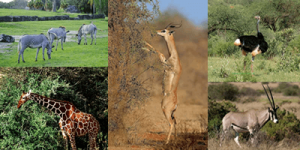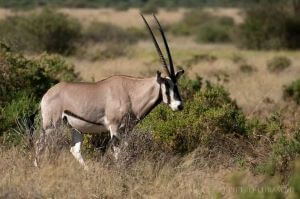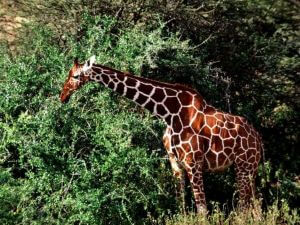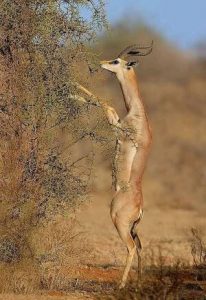
“The Samburu special five” are unique wildlife species found in Samburu Game Reserve in Kenya. They are: Beisa Oryx, Reticulated Giraffe, Grevy’s Zebra, Gerenuk and Somali ostrich, and are endemic to Samburu ecosystem. Samburu stands out for having the special five. It is one of the finest wildlife reserves in Kenya, teeming with wildlife and endless scenic landscapes. Situated alongside the Ewaso Nyiro river, there is plenty to attract wildlife from the surrounding savanna plains and therefore offers unforgettable experiences. Below are the members of the Samburu special five.
Beisa Oryx
 Also known as the East African oryx, Beisa Oryx is a species of antelope from East Africa and also a member is Samburu Special five. They live in semi desert and steppes where they eat grasses, leaves, fruit and buds. With long, straight horns and stunning face markings, the Beisa Oryx is unmistakable. Black lines streak across its nose, forehead, and down its cheeks, creating a mask-like appearance over its otherwise white head. Black badges mark its forelegs and chest. These patterns accentuate the oryx’s every movement and gesture and play a role in its complex social behavior. They gather in herds of 5-40 animals, often with females moving at the front and a large male guarding from the rear. They are able to store water by raising their body temperatures so as to avoid perspiration.
Also known as the East African oryx, Beisa Oryx is a species of antelope from East Africa and also a member is Samburu Special five. They live in semi desert and steppes where they eat grasses, leaves, fruit and buds. With long, straight horns and stunning face markings, the Beisa Oryx is unmistakable. Black lines streak across its nose, forehead, and down its cheeks, creating a mask-like appearance over its otherwise white head. Black badges mark its forelegs and chest. These patterns accentuate the oryx’s every movement and gesture and play a role in its complex social behavior. They gather in herds of 5-40 animals, often with females moving at the front and a large male guarding from the rear. They are able to store water by raising their body temperatures so as to avoid perspiration.
Reticulated Giraffe
 The reticulated giraffe, also known as the Somali giraffe, is a species of giraffe native to the Horn of Africa, a member of the Samburu special five. Giraffes are the tallest mammals in the world. Reticulated Giraffe’s coat consists of large, polygonal, liver-colored spots outlined by a network of bright-white lines. The blocks may sometimes appear deep red and may also cover the legs. The Reticulated giraffe has a relatively limited distribution across northern and north-eastern Kenya, and small restricted populations most likely persist in southern Somalia and southern Ethiopia. As a result of this decline, Reticulated giraffe were added to the International Union for Conservation of Nature Red list (IUCN) and listed as Endangered in 2018.
The reticulated giraffe, also known as the Somali giraffe, is a species of giraffe native to the Horn of Africa, a member of the Samburu special five. Giraffes are the tallest mammals in the world. Reticulated Giraffe’s coat consists of large, polygonal, liver-colored spots outlined by a network of bright-white lines. The blocks may sometimes appear deep red and may also cover the legs. The Reticulated giraffe has a relatively limited distribution across northern and north-eastern Kenya, and small restricted populations most likely persist in southern Somalia and southern Ethiopia. As a result of this decline, Reticulated giraffe were added to the International Union for Conservation of Nature Red list (IUCN) and listed as Endangered in 2018.
Grevy’s Zebra
 Grevy’s zebra are the largest of all zebra species. They are distinguished by their unique narrow stripe. Foals are brown with reddish-brown stripes, and gradually their coats darken to black. Populations of Grevy’s zebra live in Ethiopia and northern Kenya. They mainly feed on grasses but they will also consume bark, fruit and leaves. Grevy’s zebras have many other adaptations that are common to all zebras. They have long, slender legs and hoofed feet that allow them to run quickly in an effort to avoid fast-moving predators. Grevy’s zebras also have very keen eyesight. Their large eyes are set far back on their heads, which provides a wide field of vision and the ability to spot movement at great distances.
Grevy’s zebra are the largest of all zebra species. They are distinguished by their unique narrow stripe. Foals are brown with reddish-brown stripes, and gradually their coats darken to black. Populations of Grevy’s zebra live in Ethiopia and northern Kenya. They mainly feed on grasses but they will also consume bark, fruit and leaves. Grevy’s zebras have many other adaptations that are common to all zebras. They have long, slender legs and hoofed feet that allow them to run quickly in an effort to avoid fast-moving predators. Grevy’s zebras also have very keen eyesight. Their large eyes are set far back on their heads, which provides a wide field of vision and the ability to spot movement at great distances.
Gerenuk
 Gerenuk also known as giraffe gazelle is a notably tall, slender with abnormally long neck adapted to feeding on acacia trees while standing on its hind legs with wedge-like head and large, round eyes. It is characterized by its long, slender neck and limbs. They have two types of coloration which are clearly visible on their smooth coat: the reddish brown back or the “saddle”, and the lighter flanks, fawn to buff. The horns, present only on males, are lyre-shaped. Curving backward then slightly forward. Their underbelly and insides of the legs are cream in color. The eyes and the mouth are surrounded by white fur. Females have a dark patch on the crown.
Gerenuk also known as giraffe gazelle is a notably tall, slender with abnormally long neck adapted to feeding on acacia trees while standing on its hind legs with wedge-like head and large, round eyes. It is characterized by its long, slender neck and limbs. They have two types of coloration which are clearly visible on their smooth coat: the reddish brown back or the “saddle”, and the lighter flanks, fawn to buff. The horns, present only on males, are lyre-shaped. Curving backward then slightly forward. Their underbelly and insides of the legs are cream in color. The eyes and the mouth are surrounded by white fur. Females have a dark patch on the crown.
The gerenuk is a diurnal animal, active mainly during the day, though it typically stands or rests in shade during the noon. Foraging and feeding is the major activity throughout the day. Females appear to spend longer time in feeding. The gerenuk may expose itself to rain, probably to cool its body. The social structure consists of small herds of two to six members. Herds typically comprise members of a single sex, though female herds additionally have juveniles. Some males lead a solitary life.
Somali Ostrich
 The Somali ostrich, also known as the blue-necked ostrich, is a large flightless bird native to the Horn of Africa, a member of the Samburu special five also. Though generally similar to other ostriches, the skin of the neck and thighs of the Somali ostrich is blue (rather than pinkish), becoming bright blue on the male during the mating season. The neck lacks a typical broad white ring, and the tail feathers are white. The females are slightly larger than the males and browner in plumage than other female ostriches.
The Somali ostrich, also known as the blue-necked ostrich, is a large flightless bird native to the Horn of Africa, a member of the Samburu special five also. Though generally similar to other ostriches, the skin of the neck and thighs of the Somali ostrich is blue (rather than pinkish), becoming bright blue on the male during the mating season. The neck lacks a typical broad white ring, and the tail feathers are white. The females are slightly larger than the males and browner in plumage than other female ostriches.
